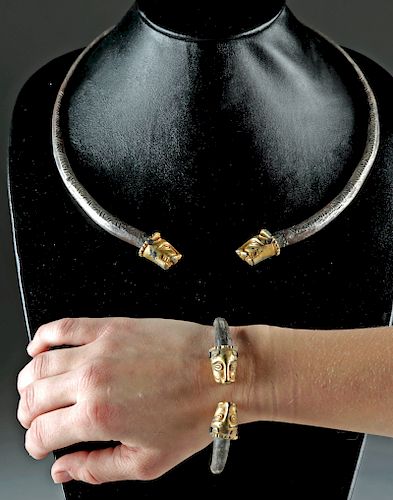Viking Gilt Silver Torq, Bracelet w/ Lion Termini, 272g
Lot 87
About Seller
Artemis Fine Arts
686 S Taylor Ave, Ste 106
Louisville, CO 80027
United States
Selling antiquities, ancient and ethnographic art online since 1993, Artemis Gallery specializes in Classical Antiquities (Egyptian, Greek, Roman, Near Eastern), Asian, Pre-Columbian, African / Tribal / Oceanographic art. Our extensive inventory includes pottery, stone, metal, wood, glass and textil...Read more
Estimate:
$9,000 - $14,000
Absentee vs Live bid
Two ways to bid:
- Leave a max absentee bid and the platform will bid on your behalf up to your maximum bid during the live auction.
- Bid live during the auction and your bids will be submitted real-time to the auctioneer.
Bid Increments
| Price | Bid Increment |
|---|---|
| $0 | $25 |
| $300 | $50 |
| $1,000 | $100 |
| $2,000 | $250 |
| $5,000 | $500 |
| $10,000 | $1,000 |
| $20,000 | $2,500 |
| $50,000 | $5,000 |
| $100,000 | $10,000 |
| $200,000 | $20,000 |
About Auction
By Artemis Fine Arts
Feb 21, 2019
Set Reminder
2019-02-21 10:00:00
2019-02-21 10:00:00
America/New_York
Bidsquare
Bidsquare : Exceptional Antiquities, Asian, Ethnographic
https://www.bidsquare.com/auctions/artemis-gallery/exceptional-antiquities-asian-ethnographic-3858
An important one-day auction featuring museum-worthy examples of Egyptian, Greek, Roman, Etruscan, Near Eastern, Far East / Asian, Pre-Columbian, African / Tribal, Oceanic, Native American, Spanish Colonial, Russian, Fossils, Ancient Jewelry, Fine Art, so much more! Artemis Fine Arts info@artemisfinearts.com
An important one-day auction featuring museum-worthy examples of Egyptian, Greek, Roman, Etruscan, Near Eastern, Far East / Asian, Pre-Columbian, African / Tribal, Oceanic, Native American, Spanish Colonial, Russian, Fossils, Ancient Jewelry, Fine Art, so much more! Artemis Fine Arts info@artemisfinearts.com
- Lot Description
Northern Europe, Viking / Norse culture, ca. 10th century CE. An exquisite ensemble of jewelry that includes a matching silver torc (torq, torque) and bracelet, both exquisitely constructed from high grade silver ( 89% silver) wire and gilded silver lion terminals (50% gold and 45% silver). Both the torq and bracelet are stamped with a lovely repeating pattern of circular motifs nested within angled double frets, with the apex of the bracelet resolving in densely delineated repeated zigzag motifs. This stunning ensemble was originally intended for a male, perhaps a leader as described, but is certainly attractive for either a male or female by today's standards. Size: torq measures 22.5" L (along perimeter) x 7.75" W (across opening) (57.2 cm x 19.7 cm); bracelet measures 9.5" L (along perimeter) x 3.25" W (across opening) (24.1 cm x 8.3 cm); total weight: 272.2 grams
In Norse mythology, a person is accompanied by a spirit known as a fylgja, and that fylgia can assume the form of an animal that reveals itself when a baby is born. The fylgja (plural fylgjur) may reflect the person's character. Men viewed as leaders were associated with various fylgjur depending on their true character. Whereas an ox, goat or boar would be associated with a "tame" nature; a lion would represent a more wild, untame nature.
Old Icelandic Viking literature brings us a story about the power of torcs such as the one included in this ensemble. The goddess Freyja owned a torc called Brisingamen, of which the first half of the compound word, brisingr, means "fire" or "amber", and the second half, "men", means "neck ring/torc of precious metal". This gleaming torc is so famous that it is mentioned in "Beowulf", the "Poetic Edda", the "Prose Edda", and the "Flateyjarbok Saga" (and later inspired a story in J. R. R. Tolkien's "The Silmarillion"). In various stories, it is stolen, often by the trickster god Loki, and Freyja's wrath is terrible until the necklace is returned to her. In the "Poetic Edda", Thor borrows Brisingamen to disguise himself as Freyja and attend a wedding in the homeland of the giants, Jotunheimr. The importance of the torc as a signifier of social standing - especially related to one of the most powerful women of the Norse pantheon - emphasizes what a fine item this example is - although we believe that this example was created for a male.
Provenance: private New York, New York, USA collection
All items legal to buy/sell under U.S. Statute covering cultural patrimony Code 2600, CHAPTER 14, and are guaranteed to be as described or your money back.
A Certificate of Authenticity will accompany all winning bids.
We ship worldwide and handle all shipping in-house for your convenience.
#141495Expected age wear with some fading to decorative motifs, although much of the decorative program is still vivid. Minor loss to gilding on lion head termini, but much gilding still remains. The precious metals have attained a warm patina over the ages.Condition
- Shipping Info
-
All shipping is handled in-house for your convenience. Your invoice from Artemis Gallery will include shipping calculation instructions. If in doubt, please inquire BEFORE bidding for estimated shipping costs for individual items.
-
- Buyer's Premium



 EUR
EUR CAD
CAD AUD
AUD GBP
GBP MXN
MXN HKD
HKD CNY
CNY MYR
MYR SEK
SEK SGD
SGD CHF
CHF THB
THB

















